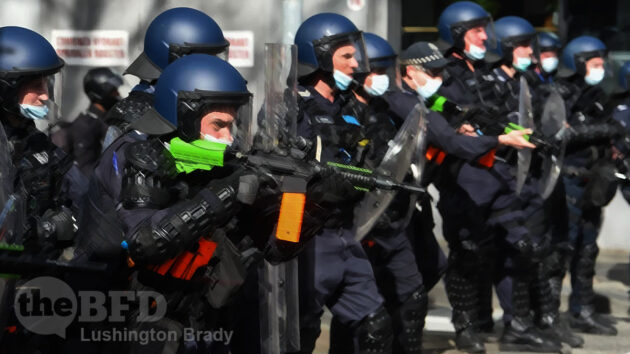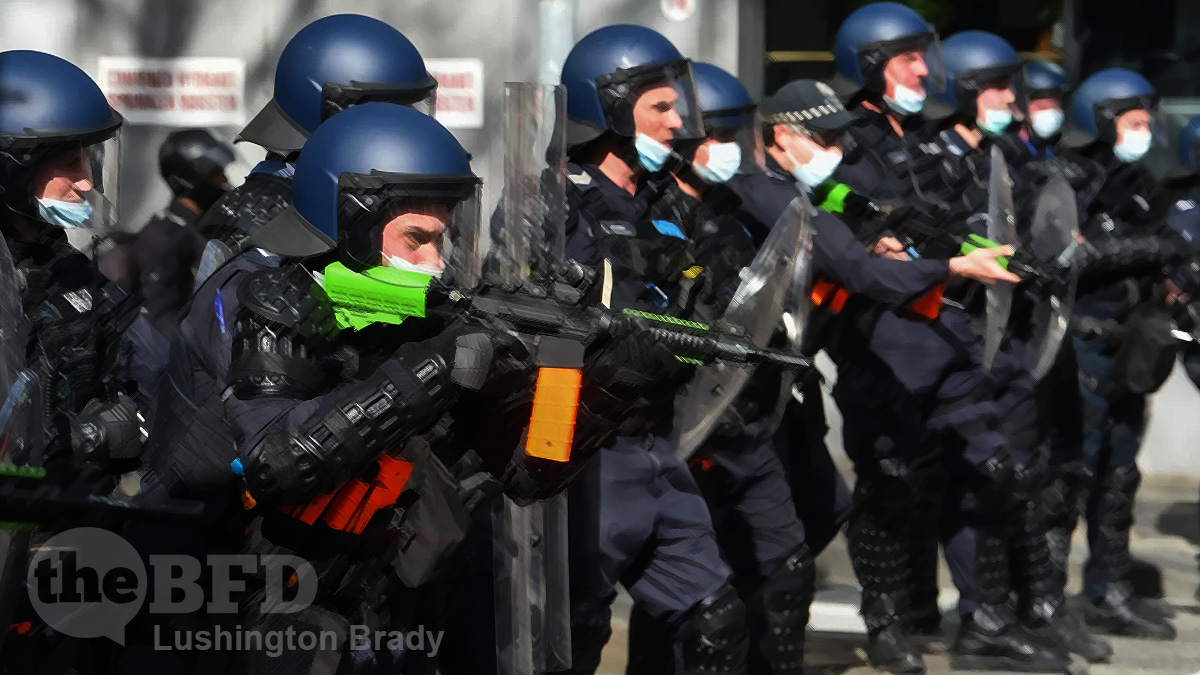The images on my computer screen were shocking. Shaky, camera phone footage of people running, screaming and yelling, as armed thugs chased after them. People desperate to escape to freedom.
No, I’m not talking about Kabul. Kabul is half a world away from me and it’s been a war zone for as long as I can remember. Little that goes on there shocks me any more. That may sound callous but it’s basic human psychology and something every journalist knows: proximity matters. What happens close to us, to places and people we are intimately familiar with, affects us vastly more than what happens to complete strangers on the other side of the world.
So watching the footage of the freedom protests in Melbourne was profoundly shocking. Teargas, pepper-spray, heavily armoured police chanting like soccer hooligans, rubber bullets.
Rubber bullets! Under the clocks of Flinders Street station! The romantic rendezvous for generations of Melbournians was suddenly a scene that more resembled Belfast in the 1980s.
I’ve been to many marches and protests; sometimes as an observer, often as a participant. Some of them got ugly; some, even violent. But I’ve never seen anything remotely like the scenes in Melbourne this weekend. Not from the protesters’ side: I’ve seen far worse-behaved crowds at the footy. But the behaviour of police was something I never expected or hoped to see in Australia.
Not even in legitimate riots, such as when hundreds of African youths fought pitched battles in the Melbourne CBD during the city’s annual Moomba celebration, as terrified families fled for cover. Sure, there was some capsicum spray used, but teargas? Rubber bullets? Nowhere to be seen. Nor were there rank upon rank of heavily armoured riot police — just a few uniformed officers pathetically trying to restore order.
The argument that the heavy police presence, and incredibly heavy-handed tactics, were justified by a pandemic lockdown simply doesn’t hold water. After all, when tens of thousands of BLM marchers descended on the CBD last year, not one was arrested or fined. In fact, police joined them in the ritualistic humiliation of “taking the knee”.
How on earth did we get here? How on earth did we arrive at a place where Melbourne — marvellous, sophisticated Melbourne, “the world’s most liveable city” — echoes to the crunch of police boots, the crack of gunfire, and the screams of protesters marching for basic human rights?
The answer lies in Australia’s federal system of government and the global political response to the Wuhan pandemic.
When Australia became a nation in 1901, the seven colonies were determined to still cling to as many of their powers and privileges as they could, now that they were states, subject to the Commonwealth. So it was that states retained the right to run their hospitals and schools, for example. Emergency management also remained a state’s right.
In the main, Australia’s federation has worked well enough. Well enough that many voters have often chosen to “have an each way bet”: voting for one party at the Federal level, another at the state.
But the federation is increasingly leading to perverse outcomes.
For instance, during the 2020 bushfires, the federal government was blamed by activists and the media for not taking action. Except that the federal government could not take action: emergency management, including firefighting, is a state responsibility (the poor management of national parks, which in large part caused the fires, is also a state responsibility).
Even more ridiculously, media clamoured for the Commonwealth to “send in the army” to rescue beleaguered towns. But the Commonwealth has no power to do so — unless expressly asked by the relevant state government.
In an eerie forecast of what was to come during the pandemic, the Victorian government held off evacuating towns like Mallacoota, or requesting federal assistance, for days. Then it heaped blame on the federal government when the town was trapped by fire.
So it is that state governments, most of them Labor, have flexed their dictatorial emergency powers during the pandemic, while holding the federal government almost literally hostage. Thanks to border closures, the Prime Minister is unable to leave Canberra or travel anywhere else in the country he is supposed to be running.
The states have also effectively wrested the running of the national economy from the Commonwealth. When premiers like Daniel Andrews have shut down their entire states for weeks on end, they have demanded that the Commonwealth bail them out with emergency welfare payments. Facing an election next year, the Morrison government has not dared say no.
So Australia is racking up tens of billions of national debt, solely to protect state premiers from the economic consequences of their authoritarian policies.
The states are also interfering in Commonwealth areas such as foreign policy. Western Australia’s government, utterly dependent on Chinese iron ore imports, undermines the Commonwealth in its trade war with China. Queensland has its own diplomatic representatives in China.
The worst foreign policy bastardry, though, belongs again to Victoria. The Victorian premier, against the expressed directions of both the federal government and intelligence services, unilaterally signing up to Xi Xinping’s notorious Belt and Road Initiative. In the end, the federal government had to enact special legislation to override the deal.
The China virus pandemic has stretched Australia’s federation to breaking point. The Commonwealth held hostage to the states. Premiers turning into out-of-control Covid dictators who are blatantly overriding Canberra on policy.
PM Scott Morrison has outlined a clear path to ending the never-ending lockdowns. But at least two Labor premiers have openly stated that they will completely ignore the federal roadmap: no matter if Australia reaches 80% vaccination, WA and Queensland have declared that they will continue to close borders and impose lockdowns as they see fit.
If the federation is at breaking-point, Melbourne is primed to explode. Growing protests are taking place in Brisbane and Sydney, too, but only Melbourne has turned into Belfast-on-the-Yarra.
But then, Melbourne is currently enduring its sixth lockdown — and second curfew. Victorians have spent 200 of the last 500 days under lockdown. Victoria’s “state of emergency” powers grant police the power to “detain any person or group for as long as reasonably necessary”, restrict the movement of any person in the state, close any premises, “require the destruction or disposal of anything”, and even allow police to enter homes and seize property without a warrant.
When the Andrews government announced the state of emergency, it said it would last four weeks. It’s now been in place for over a year, with no end in sight. The only sunset clause in Victoria is that the premier has declared it out-of-bounds to sit on the beach to watch the sunset.
This is the Australia I never thought to see. Thanks to the megalomania of state premiers, empowered by federation and fear of a pandemic, this is what we’ve become: rubber bullets under the clocks.

Please share this BFD article so others can discover The BFD.

